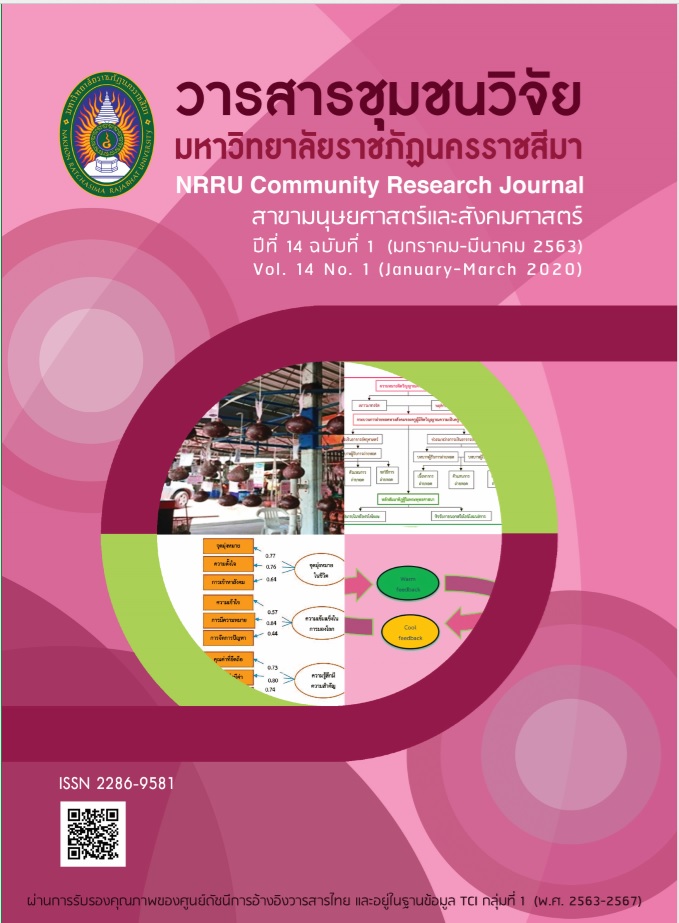การมุ่งเน้นความเป็นผู้ประกอบการและความได้เปรียบทางการแข่งขันที่ส่งผลต่อผลการดำเนินงานของธุรกิจขนาดกลางและขนาดย่อมอุตสาหกรรมอาหาร ในกลุ่มจังหวัดภาคตะวันออกเฉียงเหนือตอนล่าง
DOI:
https://doi.org/10.14456/nrru-rdi.2020.20Keywords:
Entrepreneurial orientation, Competitive advantage, Organizational performanceAbstract
This research has a purpose to examine the effect of entrepreneurial orientation and competitive advantage on organizational performance of food industry small and medium enterprises (SME) in lower North-Eastern. Populations is used in the research are 306 entrepreneurs in the SMEs food industry consisting of Nakhon Ratchasima, Chaiyaphum, Buriram and Surin provinces, by calculating samples at 99% confidence equals to 214 people and using questionnaires as a research tool. Using descriptive statistics including frequency, percentage, mean, standard deviation and hypothesis by multiple regression analysis. The focus of entrepreneurship in proactiveness (β=0.33, p<0.01) and competitive advantage in cost leadership (β=0.22, p<0.01) effect the organizational performance with statistical significant at 0.01, for entrepreneurial orientation in innovation (β=0.12, p<0.05) and competitive advantage in market-focus (β=0.17, p<0.05) effect the organizational performance with statistical significance at 0.05 level respectively. The organizational performance in the lower North-Eastern could be predicted at 68 percent (AdjR2=0.68). Therefore, entrepreneurs should pay attention to entrepreneurial orientation in proactiveness and innovation. Competitive advantage in terms of cost leadership and market-focus in order to enable the organization to be more efficient in management processes and maximize profits may drive the organization to move forward with being the market leader and bringing new technological innovations to make more qualitive products with the changes and fierce competition.
References
Chainikom, S. (2011). The Effects of Entrepreneurial Capability in Performance of SMEs in North-Eastern of Thailand. Thesis, Master of Business Administration in Technology and Electronic Commerce Management, Mahasarakham University, Mahasarakham. (In Thai)
Chandrachai, A. (2015). Balanced Scorecard (14th ed.). Bangkok : Chulalongkorn University Printing School. (In Thai)
Covin, J. G., & Slevin, D. P. (1991). A Conceptual Model of Entrepreneurship as Firm Behavior. Journal Entrepreneurship Theory and Practice, 16(1), 7-25.
David, F. R., & David, F. R. (2015). Strategic Management: A Competitive Advantage Approach, Concepts and Cases (15th ed.). Boston : Pearson Education.
Department of Industrial Works (DIW). (2019). Factory Information by Area. Retrieved January 18, 2019, from http://www2.diw.go.th/factory/tumbol.asp (In Thai)
Dess, G. G., McNamara, G., Eisner, A. B., & Lee, S. H. (2018). Strategic Management (9th ed.). New York : McGraw-Hill Education.
Ditthaanunt, P. (2016). The Effect of Supply Chain Management Practices and Supply Chain Responsiveness on Organization’s Competitive Advantage: Case of Food Industry in Thailand. Thesis, Master of Business Administration, Rajamangala University of Technology Isan, Nakhon Ratchasima. (In Thai)
Frese, M. (2000). Success and Failure of Micro Business Owners in Africa: A Psychological Approach. United States of America : Greenwood Publishing Group.
Heizer, J., & Render, B. (2014). Operation Management: Sustainability and Supply Chain Management (11th ed.). Boston : Pearson Education.
Jiraphanumes, K. (2010). The Effect of Entrepreneurial and Strategic Orientation on Innovativeness and Performance: The Empirical Study of the Listed Companies in the Market for Alternative Investment (mai). Thesis, Master of Business Administration, Walailak University, Nakhon Si Thammarat. (In Thai)
Kaplan, R. S., & Norton, D. P. (1996). The Balanced Scorecard: Translating Strategy into Action. Boston : Harvard Business School Press.
Khaimook, K. (2003). Fundamental Statistics. Bangkok : Numfon company publishing. (In Thai)
Li, S., Ragu-Nathan, B., Ragu-Nathan, T. S., & Rao, S. S. (2006). The Impact of Supply Chain Management Practices on Competitive Advantage and Organizational Performance. Omega, 34(2), 107-124.
Lumpkin, G. T., & Dess, G. G. (1996). Clarifying the Entrepreneurial Orientation Construct and linking it to Performance. Academy of Management Review, 21(1), 135-172.
Miller, A., & Dess, G. G. (1996). Strategic Management (2nd ed.). New York : McGraw-Hill.
Office of Small and Medium Enterprises Promotion (OSMEP). (2015). Thai SMEs and the Advancement to the ASEAN Economic Community. Retrieved June 20, 2018, from https://www.sme.go.th/upload/mod_download/The%20ASEAN%20SME%20Regional%20Development%20Fund%20-%20Conceptual%20Framework.pdf (In Thai)
Porter, M. E. (1980). Competitive Strategy: Techniques for Analyzing Industries and Competitions. New York : Free Press.
Rovinelli, R. J., & Hambleton, R. K. (1977). On the Use of Content Specialists in the Assessment of Criterion Referenced Test Item Validity. Dutch Journal of Educational Research, 2(2), 49-60.
Srisatidnarakul, B. (2010). Research methods: guidelines for success. Bangkok : You & I Inter media Publishing. (In Thai)





